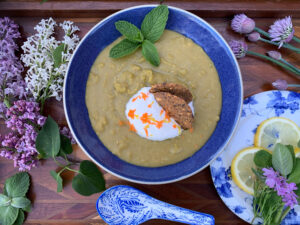
On a classic, early-80s California road trip, a carload of friends and I were breezing north on the 101. The Eagles were in the cassette deck, and there was cool wind in our big hair. We were reveling in the newly hip Central Coast – a place of wineries, California cuisine, avocados, almond groves, and Basque bar food. Feeling rather hip ourselves, we rounded a curve and were met dead-on with a piece of our pragmatic, decidedly un-hip Midwestern childhoods staring down at us. There was an inescapable billboard that said “Pea Soup Andersen’s. Splitting peas since 1924.”
At first, we thought the billboard was a remnant from advertising of decades past. Surely, California restaurants wouldn’t serve something as sensible and boring as pea soup. As we saw more Pea Soup Andersen signs, we realized we were clearly wrong. The restaurant was, and is, going strong, serving a well-loved dish. In fact, this restaurant in the heart of California wine country is currently serving 2 million bowls of pea soup a year. Whether in California, Minnesota, or north of the Arctic circle, pea soup is doing what has done since at least the early Iron Age – powering people with a highly nutritious, affordable, and versatile food that quells hunger.
The Anglo-Saxons wrote about pea soup. The Vikings just ate it.
Peas, as we know them, were found in a Bronze Age settlement in Switzerland, dating to 3000 B.C. People migrating west and north took peas with them and the legume became staple food in Anglo-Saxon England and Scandinavia. Much of what we know about peas and pea soups come from the Anglo-Saxons because they saw fit to write about them in cookbooks, in literature, and in nursery rhymes. We can surmise Viking cooking methods from the overlap of cultures and tools. We know what ingredients were involved from the chemical analysis food remains on Viking-age cookware.
Food historians Daniel Serra and Hanna Tunberg studied the foods and cooking at the Viking archaeological excavation in Lofotoen, Norway. They found that like all other settlements that have been excavated, the hearth was the heart of the longhouses and that boiling food was a typical way of cooking. It is likely that the Vikings cooked peas the same way Anglo-Saxons did. The Anglo-Saxons wrote that they would soak peas in water overnight. Then, they would boil meat in a kettle, put the peas in a cloth bag and sew the bag shut. The bag was then put in the pot with the meat.
Ramps and thyme were readily available and very likely added to the mix. Then everything was cooked until it was tender. The finished product was served in individual bowls, with slices of the meat to accompany it. This is method is easily replicated in the backyard firepit or when camping. It is simple and make a delicious broth. In the video above, Hanna is making a wheat dish, not pea soup, but the technique, as best archaeologists can tell, is the same.

Pease porridge hot. Pease porridge cold.
The Anglo-Saxons may have been conveying a recipe with this nursery rhyme. Oxford University food scholar Alan Davidson suggests that besides demonstrating how important “pease porridge,” a very thick pea soup with bacon on the side, was in the Northern diet, it may be describing a recipe for a tempeh-like product made from dried peas. However, the poem does not mention a starter for fermentation. Without a starter, “nine days in the pot” could be quite an unpleasant product. Maybe there is a second verse to the rhyme that got lost over time. Or, the rhyme could just be a complaint about how much pea soup the speaker had to eat.
Peas and piggies
From the very beginning, pea soup has had a pork product as a companion. Ham is particularly good, as the saltiness complements the peas. In The Nordic Cookbook, Magnus Nilsson lists a base pea soup recipe plus 5 variations. He suggests salted lamb if you don’t have pork. He is adamant that the meat is removed and served on the side. Otherwise, he says a bit judgmentally, one’s pea soup becomes “sloppy cafeteria food.” Well, neither you nor I would ever serve “sloppy cafeteria food,” no matter how we serve the meat. So, by all means, dice the meat and return it to the soup. You will notice in the recipes that follow the meat is returned to the soup.
Economical and easy
Patrice Johnson, the Nordic Food Geek and author of Jul: Swedish-American Holiday Traditions and Land of 10,000 Plates, recounts, “I didn’t grow up with an ärtsoppa tradition (yellow pea soup and plett pancakes as a Thursday meal), but when I was a financially strapped single mom back in the 1990s I read about the soup (and companion pancakes) in my tattered but beloved copy of Time and Life “Cooking of Scandinavia.” Back then I didn’t know the history of the soup with its origins in the Catholic fasting-prep, its rumored association with a royal assassination, or its popularity in a variety of forms across the Nordic region. But I understood that for under a dollar I could feed my daughter a nutritious and tasty dinner. It became our Thursday night tradition for a few years.”
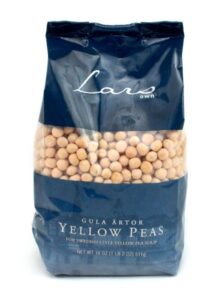
Themes and variations
Below are the recipes for three versions of pea soup. Beatrice Ojakangas shared her traditional yellow pea soup recipe, which can also be found in her cookbook, Soup and Bread. Patrice Johnson created the yellow pea soup with coconut milk and curry recipe. She developed it for the Ingebretsen’s booth at the Minneapolis Food and Wine event, an adventure which she remembers as “So much work, but so much fun.” (You can find more about that story here.) She firmly believes in incorporating flavors that one enjoys, even when they are not traditional. While warming in winter, Patrice’s soup also has a summery feel. A cup of her soup and a salad makes light dinner and both can be made ahead. The fried lefse-crisps garnish could be a meal in itself.
The Spring Pea Soup with Fresh Herbs combines fresh and dried green peas and mint. It can be thinned down with a shot of whole milk and be served chilled. Pea soup, hot or cold, yellow or green, is an excellent base for the addition of many different flavors. As Hanna Tunberg says in the Viking Age Food and Cooking video, the Vikings incorporated thyme and oregano. Patrice, who dearly loves Swedish tradition, adds orange rinds to her pea soup. I hope that you embrace the spirit of making this extremely nutritious and economical food your own by taking the recipes below and adapting them to the flavors that you like best.
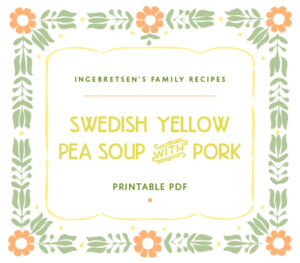
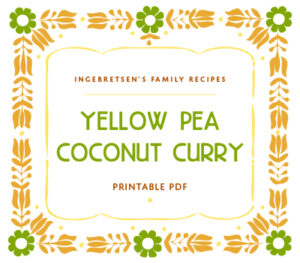
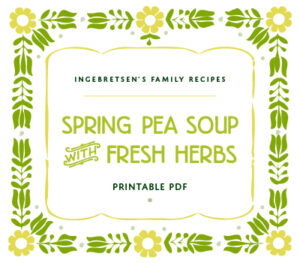
Hey, we’ve been to Pea Soup Anderson’s and had some soup, natch! Beautiful country! Enjoyable AND educational post! Thanks!
So glad you liked the post! Pea Soup Andersen’s has really become a roadside cultural institution. The power of pea soup is remarkable.
These are so much fun. Thank you for doing them.
I’m so glad you think the posts are fun to read. They certainly are fun to research and write.
Thanks for a history of Pea Soup and a fun destination!
My pleasure! If you get to Pea Soup Andersen’s, please be sure to give us a full report.
Hi Carstens: Greetings from one of the Monday Ingebretsen knitters.
Hi Donna, and a warm hello to you! Please greet the rest of the knitters for me.
We had a pea soup tradition in our family. Grandma added egg & flour dumplings to the simmering soup. So yummy! These are not the kind that rise and get fluffy….hers were more like chewy, dense dumplings. Wish I had some now on this cold and blustery day!
Oh, that sounds delicious and sustaining!